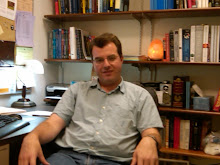I've finished Mach's Science of Mechanics. There's a lot that I don't feel like summarizing, but I will say a few things about the Bucket Problem. After reading Mach's appendices, where he elaborates on the issue, it's pretty clear that Mach's stance on the bucket problem boils down to extreme skepticism. All motion is measured relative to reference objects; otherwise experimental measurements would be impossible. When we set a bucket in motion relative to the "fixed stars" in the sky, we see centrifugal forces, but we only know that it is in motion because we step back from it and observe points on the edge of the bucket being displaced relative to other objects that we treat as fixed. It's not so much that Mach thought that there's an interaction between the bucket and the distant stars (maybe he did think that, maybe he didn't), it's that the measurements were relative to these objects and their frame, and we don't know enough about that frame to assert that there isn't something special about it.
(As an aside, it is strange that Mach attributed any significance to the "fixed stars" when Halley had demonstrated stellar motion in the early 1800's.)
Interestingly, Mach has a number of other prescient points. He rejects the idea of motion relative to ether because nobody had identified a way to pick out and track particles of ether and watch motion relative to them. Also, he made an interesting point about the optical-mechanical analogy in Hamiltonian mechanics. The progress of mechanics as a science was to move away from supernatural notions, away from the Aristotelian idea that objects go to their preferred place in the cosmos, and away from the idea of the physical world acting out some divine plan. However, the Principle of Least Action was a statement about nature optimizing something, and he refers to unnamed authors who see it as evidence of a plan. Mach notes that Fermat's Principle of Least Time, describing the propagation of light rays, was at one time seen as evidence of an intelligent hand guiding light, until the synthesis of wave and ray theories showed that ray behavior emerges from wave behavior, and the Principle of Least Time emerges with it. Mach's writing hints that the Principle of Least Action might yet be shown to be emergent from some larger theory. Schrodinger, of course, supplied that theory.
Given that the Principle of Least Action shows us the traces of a larger theory, I have to reject Mach's assertion that Lagrangian mechanics is "merely" a more economical way to formulate the same set of physical ideas as Newton. It is, rather, the cleanest trace of something bigger.
At the same time, though, I understand Mach's point that we should never confuse our theories and our taxonomy of physical concepts with the universe itself. We like to do physics in certain bases, certain sets of variables. However, the universe knows no fundamental basis. Mach would surely agree with that, even if he was sympathetic to the possibility of the "fixed stars" providing a special reference frame.
Thursday, August 20, 2015
Subscribe to:
Post Comments (Atom)



No comments:
Post a Comment